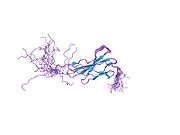Brother of CDO is a protein that in humans is encoded by the BOC gene.[5][6]
CDON (MIM 608707) and BOC are cell surface receptors of the immunoglobulin (Ig)/fibronectin type III (FNIII; see MIM 135600) repeat family involved in myogenic differentiation. CDON and BOC are coexpressed during development, form complexes with each other in a cis fashion, and are related to each other in their ectodomains, but each has a unique long cytoplasmic tail.[supplied by OMIM][6]
Interactions[edit]
BOC (gene) has been shown to interact with CDON.[5]
References[edit]
- ^ a b c GRCh38: Ensembl release 89: ENSG00000144857 – Ensembl, May 2017
- ^ a b c GRCm38: Ensembl release 89: ENSMUSG00000022687 – Ensembl, May 2017
- ^ "Human PubMed Reference:". National Center for Biotechnology Information, U.S. National Library of Medicine.
- ^ "Mouse PubMed Reference:". National Center for Biotechnology Information, U.S. National Library of Medicine.
- ^ a b Kang JS, Mulieri PJ, Hu Y, Taliana L, Krauss RS (Jan 2002). "BOC, an Ig superfamily member, associates with CDO to positively regulate myogenic differentiation". EMBO J. 21 (1–2): 114–24. doi:10.1093/emboj/21.1.114. PMC 125805. PMID 11782431.
- ^ a b "Entrez Gene: BOC Boc homolog (mouse)".
External links[edit]
- Human BOC genome location and BOC gene details page in the UCSC Genome Browser.
Further reading[edit]
- Bonaldo MF, Lennon G, Soares MB (1997). "Normalization and subtraction: two approaches to facilitate gene discovery". Genome Res. 6 (9): 791–806. doi:10.1101/gr.6.9.791. PMID 8889548.
- Strausberg RL, Feingold EA, Grouse LH, et al. (2003). "Generation and initial analysis of more than 15,000 full-length human and mouse cDNA sequences". Proc. Natl. Acad. Sci. U.S.A. 99 (26): 16899–903. Bibcode:2002PNAS...9916899M. doi:10.1073/pnas.242603899. PMC 139241. PMID 12477932.
- Kang JS, Feinleib JL, Knox S, et al. (2003). "Promyogenic members of the Ig and cadherin families associate to positively regulate differentiation". Proc. Natl. Acad. Sci. U.S.A. 100 (7): 3989–94. Bibcode:2003PNAS..100.3989K. doi:10.1073/pnas.0736565100. PMC 153035. PMID 12634428.
- Wegorzewska M, Krauss RS, Kang JS (2003). "Overexpression of the immunoglobulin superfamily members CDO and BOC enhances differentiation of the human rhabdomyosarcoma cell line RD". Mol. Carcinog. 37 (1): 1–4. doi:10.1002/mc.10121. PMID 12720294. S2CID 46652847.
- Clark HF, Gurney AL, Abaya E, et al. (2003). "The secreted protein discovery initiative (SPDI), a large-scale effort to identify novel human secreted and transmembrane proteins: a bioinformatics assessment". Genome Res. 13 (10): 2265–70. doi:10.1101/gr.1293003. PMC 403697. PMID 12975309.
- Ota T, Suzuki Y, Nishikawa T, et al. (2004). "Complete sequencing and characterization of 21,243 full-length human cDNAs". Nat. Genet. 36 (1): 40–5. doi:10.1038/ng1285. PMID 14702039.
- Kang JS, Yi MJ, Zhang W, et al. (2004). "Netrins and neogenin promote myotube formation". J. Cell Biol. 167 (3): 493–504. doi:10.1083/jcb.200405039. PMC 2172498. PMID 15520228.
- Tenzen T, Allen BL, Cole F, et al. (2006). "The cell surface membrane proteins Cdo and Boc are components and targets of the Hedgehog signaling pathway and feedback network in mice". Dev. Cell. 10 (5): 647–56. doi:10.1016/j.devcel.2006.04.004. PMID 16647304.







Well, that’s interesting to know that Psilotum nudum are known as whisk ferns. Psilotum nudum is the commoner species of the two. While the P. flaccidum is a rare species and is found in the tropical islands. Both the species are usually epiphytic in habit and grow upon tree ferns. These species may also be terrestrial and grow in humus or in the crevices of the rocks.
View the detailed Guide of Psilotum nudum: Detailed Study Of Psilotum Nudum (Whisk Fern), Classification, Anatomy, Reproduction